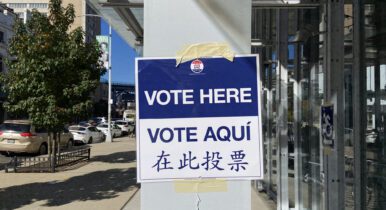How the Harris Campaign Blew the Latino Vote
Internal consternation and budget cuts for Latino outreach hobbled former Vice President Kamala Harris’ campaign’s efforts to reach a critical voting bloc in the weeks and months leading up to Election Day, according to one of her chief bilingual ad makers.
During a panel discussion at the 2025 Reed Awards in Austin, Texas last week, Colin Rogero offered a bleak assessment of the Harris campaign’s approach to Latino outreach. Dedicated budgets intended to help the candidate reach Latinos “were the first thing to be cut in that campaign and were cut every single month,” he said.
Ads that Rogero said could have helped sell Harris’ record to Latino voters – including a spot on border security – were tabled out as campaign officials argued “back and forth about whether or not we should take on these tough issues, because we might upset this person or that person.”
“I couldn’t get a border security ad done until the last three weeks of the campaign,” said Rogero, the co-founder and creative director at the Democratic media agency Conexion. “We had one six months before.”
The campaign also discounted the advice of officials familiar with the Latino community – a decision many former campaign staffers expressed frustration about throughout Harris’ four-month White House bid.
“There was not equal weight given to folks sitting around the primary decision table with the understanding of this community and how, if we were serious about winning, we were going to be able to win them,” Rogero said.
A Hard Night for Harris
The end result on Election Day was ultimately damning for Harris. She won just 51 percent of the Latino vote nationally, while President Donald Trump carried 46 percent – a 14-point decrease from 2020 when former President Joe Biden carried 65 percent of the Latino vote, according to exit polling.
She also underperformed among Latinos in key battleground states, like Arizona and Pennsylvania. In Nevada, where roughly 1 in 5 voters identify as Latino, Trump narrowly won the demographic group, exit polls show.
Harris’ struggle to win over Latino voters was, in some ways, unique to her campaign. In Arizona, for instance, Democratic Sen. Ruben Gallego performed 6 percentage points better among those voters than Harris did. Rogero said that Gallego’s success was due, in part, to the fact that he “was unafraid to run right into these very difficult issues.”
“That was not the case at the top of the ticket,” Rogero said.
Rogero said that the problem wasn’t Harris herself. In focus groups, he said, voters responded positively to her candidacy when they got to know more about Harris and her track record, “especially as [the California] attorney general fighting to protect working-class people, mainly Latinos.”
But ultimately, he said, the campaign didn’t invest the resources needed to sell that record to Latino voters.
“We had a great story and a great ad that we wanted to run and tell the story about her protecting carwash workers, who were just not getting paid, while these folks were running away with the money,” Rogero said. “We could never get there to kind of get them to invest in the way that was necessary.”

